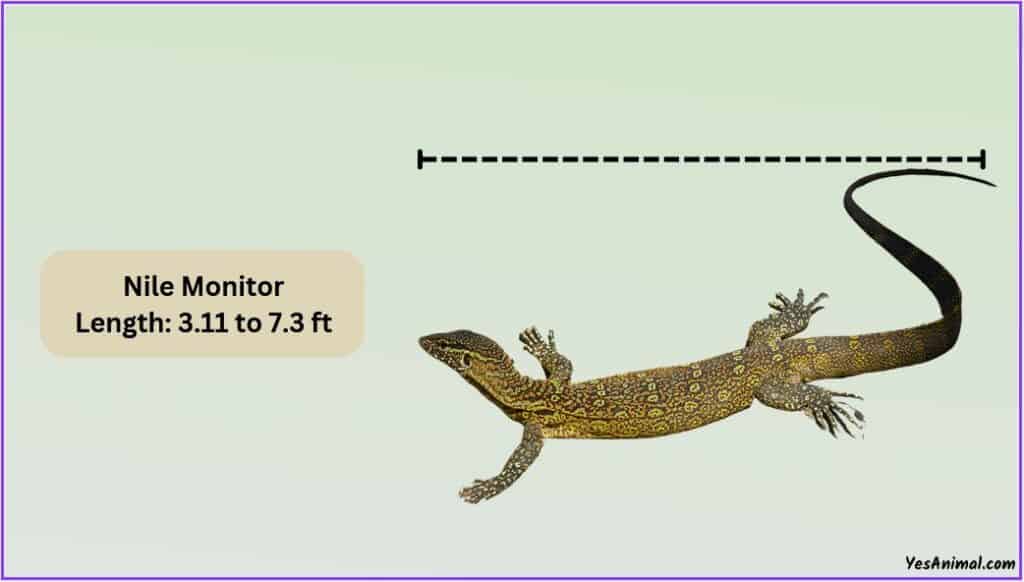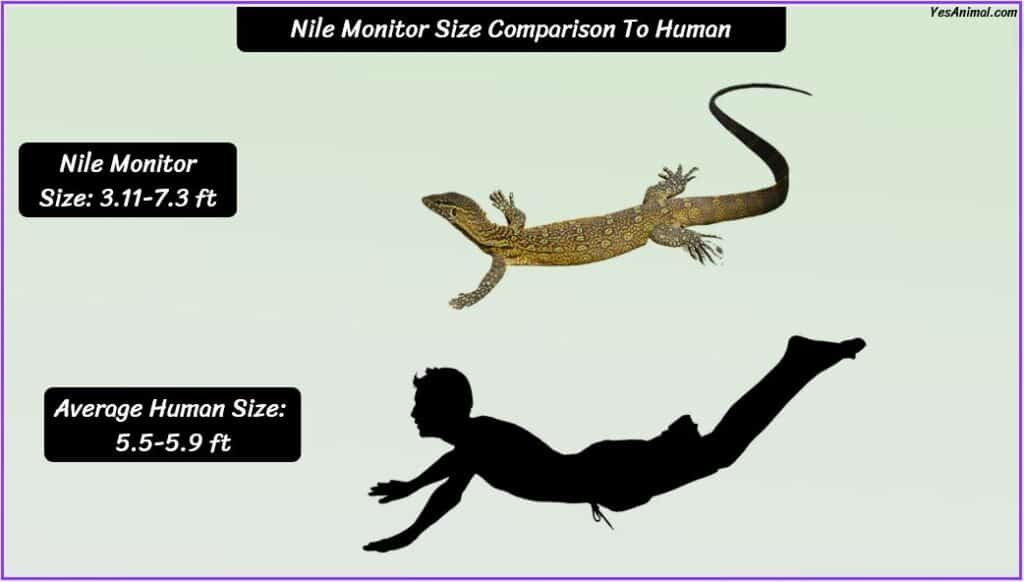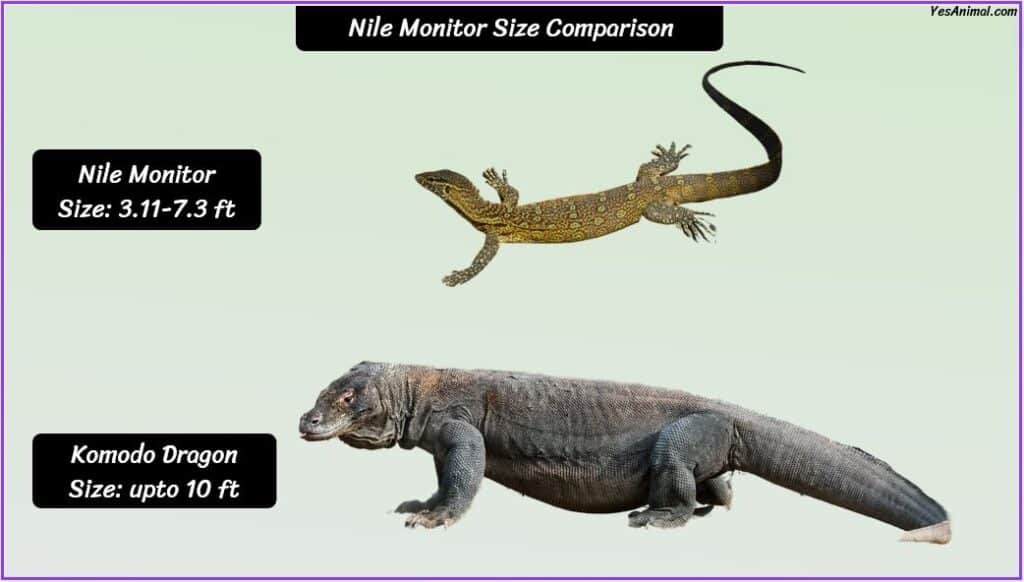Last Updated on April 11, 2023 by Amin Tawar
Nile Monitor Length

The Nile Monitor is a large species of lizard that can be found in Africa, specifically in countries along the Nile river. Their body shape is elongated and robust, with a triangular head and strong jaws.
Additionally, their body is covered with smooth scales that vary in color from dark brown to black, with yellow or white spots. While their appearance is a great way of spotting them, you can also find them using their size.
When it comes to size, the Nile Monitor is an extremely interesting creature to look for. Adults of the subspecies can reach an average total length of about 120 to 220 cm (3 ft 11 in to 7 ft 3 in), while some are even larger with a record length of 244 cm (8 ft). This makes them one of the larger species of lizards found in Africa.
| Nile Monitor Length | Meters | Feet |
| Average | 1.2 to 2.2 m | 3.11 ft to 7.3 ft |
| Maximum | 2.44 m | 8 ft |
Nile Monitor Weight
Moreover, Nile Monitor is an opportunistic feeder, and their diet is composed of a variety of prey, including fish, crustaceans, amphibians, reptiles, birds, and small mammals. They are also known to prey on domestic animals if they have the opportunity. The heavy diet of the species is quite dependent on its heavy weight.
So when it comes to weight, the Nile Monitor is a heavy reptile. Adults can reach up to 15 pounds on average and have a record weight of 17.8 pounds, making them one of the heaviest lizards found in Africa.
This weight is distributed throughout its body, giving it a sturdy and powerful build, with an elongated and robust body shape. The Nile Monitor’s weight not only allows them to be great predators but also to survive in harsh environments.
For instance, the Nile monitor’s weight also gives them an advantage when it comes to hunting.
| Nile Monitor Weight | Kilograms | Pounds |
| Average | 6.8 kg | 15 pounds |
| Maximum | 8.07 kg | 17.8 pounds |
Nile Monitor Lizard Egg Clutch Size
The Nile Monitor eggs are an important food source for many animals in the wild, such as snakes, birds, and other lizards. The eggs are also collected by people for food or for trade. The Nile Monitors eggs have a high protein content and are considered a delicacy in some cultures.
The size of their egg clutch varies depending on the species and location of the monitor, but on average, females will lay around 20-30 eggs per clutch.
The eggs of these creatures are large, about the size of a chicken egg, and are laid in a nest of soil or vegetation.
The eggs are typically laid during the rainy season when the conditions are ideal for the eggs to develop and hatch. The eggs take around 2-3 months to hatch, and the hatchlings are about 20-30 cm (8-12 inches) long. 1
Baby Nile Monitor Size
“Small but mighty” could easily describe the baby Nile monitor, as these miniature versions of their adult counterparts pack just as much of a punch, despite their diminutive size.
When born, baby Nile monitors are usually around 8-10 inches long, and they weigh around 2-3 ounces.
Their small size and delicate appearance may be deceiving, but don’t let that fool you – these babies are tough and ready to take on the world.
One of the most striking things about baby Nile monitors is their striking resemblance to their adult counterparts.
Even at a young age, they have the same elongated bodies, powerful legs, and sharp claws that make them such formidable hunters. They also have a keen sense of smell, which allows them to detect prey even as newborns.
Nile Monitor Size Comparison To Humans

The size of the Nile Monitor when compared to humans is quite striking. Fully grown Nile monitors can reach up to 120 to 220 cm (3 ft 11 in to 7 ft 3 in) in length and weigh up to 6.8 kg (15 pounds), while the average human is around 5.5 to 5.9 feet tall and weighs 150 pounds (60 to 80 kgs).
This size difference can be quite intimidating, but it also highlights the unique adaptations that have allowed Nile monitors to thrive in their natural habitat.
While Nile monitors are physically much larger than humans, they also possess other adaptations that set them apart.
One of the most obvious adaptations that Nile monitors possess is their elongated bodies and powerful legs, which allow them to move quickly and efficiently through the water, where they spend a significant portion of their time.
Nile monitors are also excellent swimmers and can hold their breath for extended periods of time, allowing them to chase prey or evade predators underwater. This is a key survival strategy that allows them to thrive in the wetlands and rivers of Africa.
| Animal type | Length | Weight |
| Nile Monitor | 120 to 220 cm (3 ft 11 in to 7 ft 3 in) | 6.8 kg (15 pounds) |
| Average adult human | 5.5 to 5.9 feet | 150 pounds (60 to 80 kgs) |
Nile Monitor Size Vs Komodo Dragon Size Comparison

One of the most common features of both of these creatures is their size and hunting powers. Nile monitors can reach up to 120 to 220 cm (3 ft 11 in to 7 ft 3 in) in length and weigh up to 6.8 kg (15 pounds), while Komodo dragons can grow up to 3 meters (10 feet) long and weigh over 70 kg (150 lb). Both species are apex predators, but their size and adaptations make them quite different from one another.
Despite their size and hunting abilities, both Nile monitors and Komodo dragons are threatened by a number of factors, including habitat loss and over-exploitation.
Nile monitors are also sometimes hunted for their skin, which is used to make leather goods. In order to protect these fascinating animals, conservation efforts are underway to protect their habitats and regulate hunting.
| Animal type | Length | Weight |
| Nile Monitor | 120 to 220 cm (3 ft 11 in to 7 ft 3 in) | 6.8 kg (15 pounds) |
| Komodo Dragon | 7.5-8.5 ft | 70 kg (150 lb) |
Nile Monitor Size Vs Crocodile Size Comparison
You would have seen wild crocodiles in one of your zoo visits, and you would surely be astonished by their tremendous strength and large size.
However, have you ever wondered how large or small these species are when compared to the Nile Monitors?
While the Nile monitors have an average size of 120 to 220 cm (3 ft 11 in to 7 ft 3 in) in length and 6.8 kg (15 pounds) in weight. On the other hand, the Crocodile is 6 meters (20 feet) in length and 1,000 kg (about 2,200 pounds) in weight.
So, you can see that the Crocodile is double the size of the smallest Nile monitor and a lot heavier.
| Animal type | Length | Weight |
| Nile Monitor | 120 to 220 cm (3 ft 11 in to 7 ft 3 in) | 6.8 kg (15 pounds) |
| Crocodile | 6 meters (20 feet) | 1,000 kg (about 2,200 pounds) |
Nile Monitor Vs Asian Water Monitor Size Comparison
Both the Nile monitor and the Asian water monitors are subspecies of water monitors. However, there are great differences between the two. One of the most obvious differences between the two species is their size.
For instance, the Nile monitor has an average length of 120 to 220 cm (3 ft 11 in to 7 ft 3 in) and an average weight of 6.8 kg (15 pounds).
In contrast, the Asian water monitor is quite larger but lighter, with an average length of 56.6 to 59 cm (22.3 to 23 inches) and average weight of 3.42 to 3.52 kg (7.5 to 7.8 pounds).
So, although they are close relatives they have a lot of differences.
| Animal type | Length | Weight |
| Nile Monitor | 120 to 220 cm (3 ft 11 in to 7 ft 3 in) | 6.8 kg (15 pounds) |
| Asian Water Monitor | Male – 56.6 cm (22.3 in) Female – 59 cm (23 in) | Male – 3.42 kg (7.5 lb) Female – 3.52 kg (7.8 lb) |
Conclusion
And that was everything you need to know about the size of Nile Monitor. I hope this article was informative enough and your queries were answered.
Thank You For Reading!
Related Articles You May Like